About
Historic Murals at the School of Government
In 1954 Margaret Rutledge Knapp commissioned fourteen murals depicting events and themes important to the development of North Carolina. A gift for the Institute of Government’s new Assembly Hall, the murals were funded by $100,000 from the Joseph Palmer Knapp Foundation of New York. Themes were suggested by a local committee, which was led by Albert and Gladys Coates. The artist, Frances Vandeveer Kughler, chose those he thought best expressed the spirit of the state.
The original 14 murals were executed in oil on canvas over the course of six years in England; Manteo, North Carolina; the UNC-Chapel Hill campus; Williamsburg, Virginia; and in the artist’s New York studio overlooking Central Park. The entire series was installed at the Institute of Government in November 1960. When renovation of the School of Government’s auditorium began in 2002, the murals were removed and cleaned. Eight now hang in the Knapp-Sanders Building. Five are in storage at UNC, and one is on loan in Manteo.
In composing the murals, Kughler chose to depict characters important to a particular era alongside figures of historical importance from both earlier and more recent times. In one mural, for example, Frank Porter Graham, president of UNC-Chapel Hill from 1930 to 1949, is depicted with William R. Davie at the laying of the cornerstone for the University of North Carolina’s first building in 1793.
Although important historically, the murals lack recognition of the many contributions of the state’s African American and Native American citizens. The School of Government has commissioned at least one work to focus on these leaders, creators, educators, and others who made major contributions to the rich history and cultural fabric of the state.
In 2008 a committee of arts professionals and School of Government faculty and staff was recruited to select artists for two new paintings depicting major figures and events from North Carolina’s African-American history. Thanks to a gift provided by Local Government Federal Credit Union, the first of the new works, SERVICE, was dedicated at the School of Government on July 26, 2010. This date coincided with the 50th anniversary of the desegregation of the Woolworth lunch counter in Greensboro, North Carolina.
SERVICE Mural
1ST FLOOR, KNAPP-SANDERS BUILDING
Working around the concept of “service,” South Carolina artist Colin Quashie conceived a 5’ x 50’ oil-on-canvas painting that presents a creative interpretation of the pivotal 1960 sit-in at the Woolworth lunch counter in Greensboro. The mural features the Greensboro Four—Joseph McNeil, David Richmond, Jibreel Khazan (formerly known as Ezell Blair Jr.), and Franklin McCain—as chefs because, as Quashie explains, “they literally took possession of the lunch counter with their refusal to leave until served. By seeking service they were, by extension, serving a cause greater than themselves.” Forty additional individuals and eight events symbolizing North Carolina’s African American history associated with civil rights, government, business, journalism, and education are also showcased.
Kughler North Carolina History Murals
HODGES LOBBY, KNAPP-SANDERS BUILDING
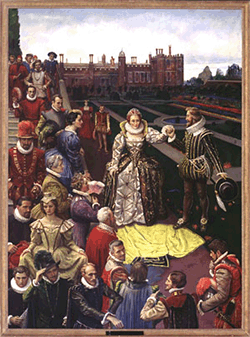
Meeting of Queen Elizabeth and Walter Raleigh
Many prominent figures in Elizabeth's court are represented in a scene set in the gardens of Hampton Court, the Queen's summer palace. Apart from the Queen and Sir Walter, onlookers include Dr. John Dee, the Queen's astrologer; John Bull, the court organist; Elizabeth Throckmorton; Sir Christopher Hatton; Sir Francis Walsingham; William Cecil, Lord Burghley; Robert Dudley, Earl of Leicester; Henry Carey, Baron Hunsdon; Sir Francis Drake; Sir Humphrey Gilbert; and Francis Bacon as a youth.
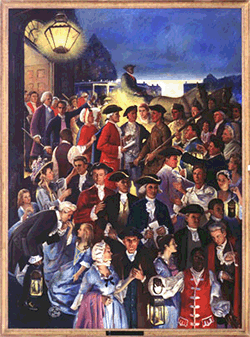
Halifax Resolves
This mural depicts the delegates to the Fourth Provincial Congress at Halifax leaving the meeting house at nightfall on April 12, 1776, after they had voted "to concur in independency" by adopting the Halifax Resolves. Among those in the scene are Samuel Johnson, Thomas Burke, and Cornelius Harnett. This mural was painted in Williamsburg, Virginia, where Paul Green's drama "The Common Glory" was playing at the time, enabling Kughler to use the costumes and actors as models.
ATRIUM, KNAPP-SANDERS BUILDING
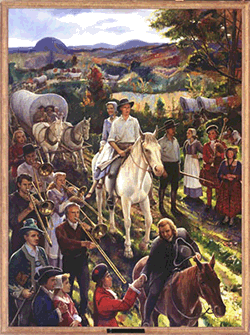 Road to Carolina
Road to Carolina This scene depicts a meeting of two caravans on the road to Carolina. A group of Scots about to break camp is greeted by Count Nicolaus von Zinzendorf, leader of a band of Moravians moving on to their first settlement while playing their trombones. Trombone quartets, called "Trombone Choirs," were traditional and the earliest Moravians to arrive in North Carolina had many skilled musicians and composers among them.
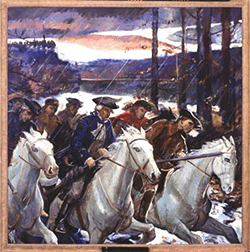 On to Kings Mountain
On to Kings MountainThis mural, painted in Chapel Hill, represents the ride of the mountaineers to make a surprise dawn attack on the Tories encamped on Kings Mountain. On the night preceding the Battle of Kings Mountain, the men with the best mounts were selected to ride ahead to attack before the enemy could be alerted. They fastened identifying sprigs of pine to their hats and rode hard through cold rain with their rifles wrapped in their coats to keep them dry.
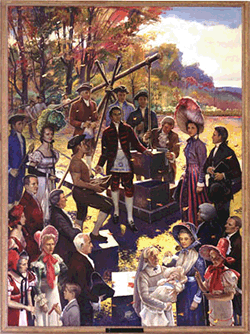 Founding of The University of North Carolina
Founding of The University of North CarolinaWilliam Richardson Davie in Masonic regalia is shown laying the cornerstone of Old East, the first university structure, on a brisk October afternoon in 1793. Near the bottom of the scene, Frank Porter Graham (President of the University in the 1930s and '40s) and Marian Drane Graham witness the ceremony. The model for the woman standing to Davie's right was a lineal descendant of Davie.
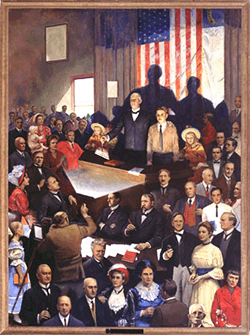 Crusade for Education
Crusade for EducationThis mural portrays Governor Charles B. Aycock addressing an audience in the House chamber of the state capitol in his crusade for education around 1900. The audience includes prominent North Carolina educators spanning a number of decades before and after the time in which this mural is set. Among those pictured are William C. Friday, William B. Aycock, William D. Carmichael, Robert B. House, Adeline McCall, Josephus Daniels, J.M. Broughton, Cornelia Spencer, Major L.P. McLendon, Ida and Dudley Bagley, Horace Williams, Marcus C.S. Noble, and Charles Duncan McIver.
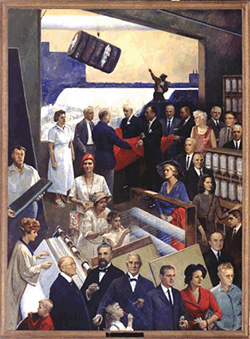 Industrial Awakening
Industrial AwakeningThis mural represents the great development of industry that occurred in North Carolina around the turn of the century. Lack of space limited the artist, thus he painted the textile industry as representative of all the others since it embodied a far-flung gathering of varied skills and talents. The setting is the interior of a textile factory around 1920. Among the industrial and business leaders depicted here are: (At the top) Clarence Poe, editor of the Progressive Farmer magazine; Ben and Caesar Cone, Spencer Love, Bowman Gray, Julian Price, James Hanes. (At the bottom) John Motley Morehead, James B. Duke, and R.J. Reynolds.
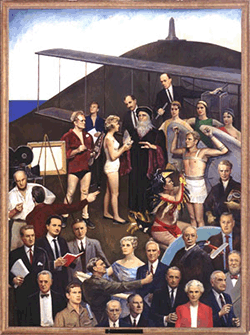 Pageant of Dreamers
Pageant of DreamersLacking sufficient space to handle as separate murals many important events of a creative nature that have taken place in North Carolina, Mr. Kughler hit upon the idea of combining them into one mural depicting a drama group rehearsing a pageant of dreamers. Cecil B. deMille films the production while Frederick Koch directs. Among those pictured are Thomas Wolfe, Paul Green, Andy Griffith, Albert and Gladys Coates, Robert Lee Humber, Katherine Pendleton Arrington, Edwin Gill, Benjamin Swalin, William Sidney Porter (O. Henry), Walter Hines Page, Jonathan Daniels, and William Polk. The artist himself paints the scene at Kitty Hawk in the company of Wilbur and Orville Wright, Leonardo da Vinci, Charles Lindbergh, Icarus, and a Cherokee dancer.
Kughler Murals Located Off-site
Lafayette in the Old South
Currently in storage, UNC-Chapel Hill
Gettysburg
Currently in storage, UNC-Chapel Hill
Into the Space Age
Currently in storage, UNC-Chapel Hill
Pleiades, Mystery of the Future
Currently in storage, UNC-Chapel Hill
First English Colony
Outer Banks History Center, Manteo
Charles II and the Lord’s Proprietors
Currently in storage, UNC-Chapel Hill


